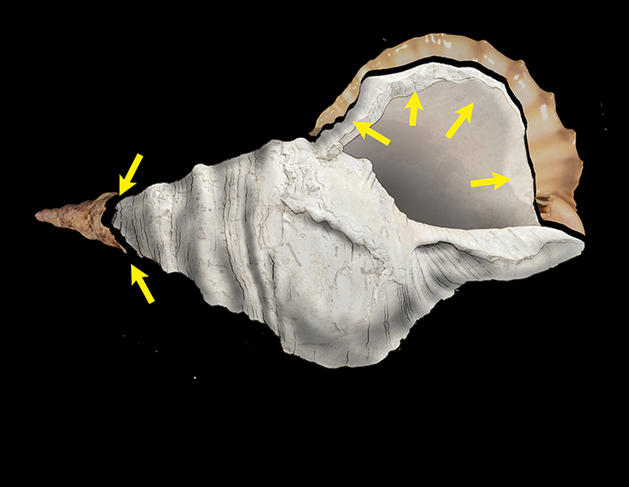Lying unnoticed for years in the collections of Toulouse’s Museum of Natural History, in southwestern France, a hidden treasure has finally given up its secrets. The true purpose of the 30-centimetre-long shell, described as a “water pitcher” when it was discovered in 1931 at the entrance to the Marsoulas painted cave in the Pyrenees, was revealed by archaeologists, whose findings have been published in the journal Science1. Far from being used as a container, the conch belonging to the species Charonia lampas – a mollusc still found today in the Bay of Biscay, along the western coast of France and northern coast of Spain – astonishingly turns out to be a wind instrument. This makes it the first shell trumpet from the Palaeolithic period ever identified. The object dates from the time the Pyrenean painted cave was first occupied by Magdalenian humans 18,000 years ago.
“It has been acknowledged for several decades that Palaeolithic populations had a musical culture. The oldest known wind instruments are flutes made from vulture bones. One found in the Isturitz cave in the French Basque Country is 35,000 years old, while another from Hohle Fels in southwestern Germany dates from 40,000 years ago. However, no conch horn had ever been found,” explains Carole Fritz, head of the Emile Cartailhac Prehistoric Art Research and Study Center (CREAP)2 and a researcher at the TRACES3 laboratory, who recounts her amazement on first hearing the sound produced by the conch one day in 2018. “I was in the middle of cataloguing the objects found in the various stratigraphic layers of the Marsoulas cave in order to draw up a detailed chronology of the site, when the head of the museum’s prehistoric collections showed me a shell and said, “Did you know you can get a lovely sound out of this?” The low, powerful note he produced was astounding: this had to be a musical instrument! And the hole into which my colleague was blowing, at the top of the shell, couldn’t have got there by accident.”
In-depth examination of the conch showed that it had indeed been adapted by the Magdalenian humans of Marsoulas to turn it into an aerophone, in other words a wind instrument. “Specialists told me that such shells are extremely hard, and that there is no way in which the tip, or apex, could have been accidentally separated from the specimen,” the scientist explains. Another hole, made inside, in the second whorl, and revealed by tomography performed on the imaging platform of the French space agency, CNES, confirmed that human intervention was involved. Another modification can also be seen : the outer lip of the shell’s aperture was cut to make it narrower.

The researchers invited a professional horn player to come and blow into the conch. An analysis of the frequencies generated identified three sounds close to the notes C, C sharp and D. “He couldn’t get anything else out of it, because the sharp edge of the hole prevented him from positioning his lips correctly,” Fritz says. “Nonetheless, the notes produced by the shell supported our intuition: this was well and truly a musical instrument!” Asked to give his opinion, Emmanuel Kasarherou, the director of the Quai Branly Museum in Paris, could only verify the similarity of the piece with the shell trumpets found in the museum’s collections dedicated to the indigenous arts. “In the Pacific, conch shells are extremely common and are still used to make musical instruments,” explains Kasarherou, who has conducted a study of these different wind instruments.
“Among the twenty or so Charonia in our collections, most of which were assembled in the nineteenth century, I have observed two ways of adapting the shell and playing it,” the curator says. “Either by making a lateral perforation, which enables the musician to adjust the sound easily by placing their hand in the shell’s aperture, or by making a hole in the apex similar to the one found in the Marsoulas specimen.” In the latter case, a mouthpiece made of natural wax is commonly added in order to facilitate the musician’s playing, which could explain the traces of organic matter found near the tip of the Marsoulas conch.
The hole in the second whorl, on the other hand, is more intriguing, since an endoscope examination of the Quai Branly shells failed to reveal anything similar. One of the researchers’ hypotheses, which remains to be validated, is that a small bird bone – which are known to be hollow – may have been inserted into the two openings.
In what context was the Marsoulas conch played by our Magdalenian forebears? “It probably wasn’t an everyday object. The traces of red dots visible inside the aperture, similar to those of the bison painted on the walls of the cave, suggest that the instrument was more likely used for ceremonial purposes,” believes Kasarherou, alluding to the richly decorated conch shells of the Marquesas Islands and Japan, played to accompany certain specific rites. In any case, Fritz is sure of one thing: “The conch and the cave are closely connected and cannot be considered separately.” Thanks to 3D printing, it has proved possible to make an exact copy of the conch shell. This will enable the researchers not only to continue exploring all its acoustic possibilities, but also to make it resound once again in the Pyrenean cave where it was first turned into a musical instrument, some 18,000 years ago.
Footnotes
- 1. Carole Fritz, Gilles Tosello, Guillaume Fleury, Emmanuel Kasarhérou, Philippe Walter, Francis Duranthon, Pascal Gaillard, Julien Tardieu, “First record of the sound produced by the oldest Upper Paleolithic seashell horn” Science Advances, 10 February 2021. DOI : 10.1126/sciadv.abe9510
- 2. CNRS / Université Toulouse – Jean Jaurès / MSHS Toulouse.
- 3. Travaux et Recherches Archéologiques sur les Cultures, les Espaces et les Sociétés (CNRS / Université Toulouse – Jean Jaurès / Ministère de la Culture).


